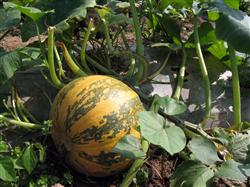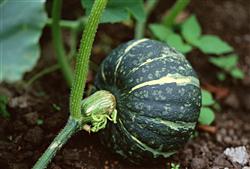What are the characteristics of pumpkin fertilizer?

What are the characteristics of pumpkin fertilizer? Please introduce in detail the characteristics of fertilizer requirement of pumpkin: (1) the characteristics of fertilizer absorption of pumpkin: the root system of pumpkin is well developed, the main root can be buried in about 2 meters, and the first lateral root has more than 20, about 50 cm long, the longest can reach 140 cm, and can be divided into three or four lateral roots, forming a strong root group, the main root group is densely distributed in the plough layer of 10 cm to 40 cm. Because the pumpkin root is deep in the soil and widely distributed, it has a strong ability to absorb fertilizer and water, and has strong drought resistance and barren resistance. It is not strict with the soil, and it can grow even in barren plots. When pumpkin is cultivated in heavy and fertile soil, the yield is not high because of the excessive growth of stems and leaves. Therefore, early-maturing cultivation should choose sandy loam with deep soil layer, good drainage and rapid heating, while late-maturing varieties should choose loam with strong water and fertility conservation and suitable soil pH6.5~7.5. When the soil fertility is sufficient, reasonable close planting, timely pruning and coring can be made full use of to obtain high yield. (2) the dynamics of fertilizer requirement of pumpkin: the amount and proportion of nutrients absorbed by pumpkin were different in different growth and development stages. Less fertilizer was needed in the seedling stage, and the largest amount of fertilizer was needed in the fruit expansion stage, especially the absorption of nitrogen increased sharply, potassium also had a similar trend, and the amount of phosphorus uptake increased less. According to the study of Miyazaki, Japan, in the 137 days from planting to pulling seedlings, the absorption of five elements (nitrogen, phosphorus, potassium, calcium and magnesium) by pumpkin increased slowly in the first 1, and increased rapidly in the middle. The last one increased most significantly in the last 3 days. The absorption of the five elements in the whole period was the most in potassium and nitrogen, the middle in calcium and the least in magnesium and phosphorus. The increase in yield is completely consistent with the general trend of the absorption of the five elements, and it also increases rapidly in the last one and three. The production of 1000 kg pumpkin requires the absorption of nitrogen (N) 3.5-5.5 kg, phosphorus (P2O5) 1.5-2.2 kg, potassium (K2O) 5.3-7.29 kg. Pumpkins respond well to organic fertilizers such as barnyard manure and compost. Too much nitrogen fertilizer in the early growth stage of pumpkin is easy to cause the stem and leaf to grow and the head melon to fall off; too late application of nitrogen fertilizer will affect the fruit expansion. Click to get more pumpkin planting techniques click to get more vegetable planting techniques
- Prev

How should seed pumpkins be managed?
How should seed pumpkins be managed? Please give guidance to seed pumpkin management can refer to the following methods: early seedlings early set seedlings between pumpkin seedlings early rather than late, early seedlings, fixed seedlings, conducive to ventilation and light, promote early growth and rapid development of seedlings, generally start seedlings with hands, it is best to fix seedlings during 2-leaf period and 3-leaf stage.
- Next

How do powdery pumpkins grow in the mountains in summer?
How do powdery pumpkins grow in the mountains in summer? Please introduce in detail that powdered pumpkin has the advantages of strong adaptability, short growth period, good melon type, waxy taste, sweet palatability, rich nutrition, excellent quality, high yield and so on. Powdered pumpkin varieties are chestnut pumpkin, Dongsheng pumpkin.
Related
- Where is it suitable to grow horseradish in China? it is expected to see the middle altitude horseradish in Alishan.
- How to prevent tomato virus disease reasonably? (Control methods included)
- Many people like to plant towel gourd on the balcony. What are the main points of this method and management?
- What crops can chili peppers be mixed with?
- Fertilization techniques and matters needing attention in Tomato
- What are the grafting techniques for peach seedlings in spring?
- Harm and control methods of root swelling disease of Chinese cabbage
- What are the pests of sweet potatoes? How to prevent and cure it?
- Symptoms, causes and Control methods of navel Rot in Tomato
- The cause of "Cucumber rotten bibcock" in Farmers' planting Cucumber and its Control Plan

